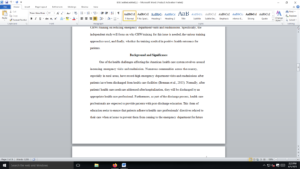Environmental health and safety programs
You will work looking for articles which can document if the training of CHWs can improve health in the specific area of your interest. I will post a rubric – outline below but for now see these instructions.
Instructions
The Community Training course which is taught online introduces you to health education topics and competencies. One way this skill can be used is to train community health workers to perform a specific task within a community or a number of tasks. For this Independent Study I would like you to think of a setting or a health issue of interest to you and do a literature review finding cases where community health workers have been trained to address these issues in their communities and see if you can find some evidence of positive health outcomes as a result of training these CHWs.
As you search you may find other ‘names’ for CHWs like: health coach, community health advisor, family advocate, health educator, liaison, promoter, outreach worker, peer counselor, patient navigator, health interpreter, public health aide, etc.. Use the PHA guidelines (you can find them on the SPHTM Website) to format your paper and Word count etc. It might also help to look at the IS Guidelines that will be in Canvas to give you ideas. In the U.S. you may find these “CHWs” are persons who help patients manage specific diseases such as diabetes.
- Descriptive title of independent study. This title will appear on the student transcript. The title cannot be more than 30 characters including spacesNumber of credits
- Description of independent study – 120 words
- Three course objectives
- Integrate the fundamentals of project management into occupational and/or environmental health and safety programs.
- Implement financial management within an occupational health and safety programs.
- Analyze safety and health investment strategies and cost/benefits of health and safety.
- Apply systems thinking to occupational/ environmental health programs and strategic management.
- Evaluate the program performance for ongoing improvement.
- Course product – must be a high quality written document. Determine the type of document, length, and other expectations for the product
- Grading rubric
I am attaching the rubric and I will use it to grade your paper. Use each section of the rubric as an “Outline – Title” which will tell me what you are doing in each section of your paper. In other words if you paper is just 15-20 paragraphs one after the other I find it difficult to determine your goal with each paragraph. If you follow this out line and title each section I just go through and check to see if you have addressed the purpose of each section and it is easier for you to get full credit on your paper. Let me know if you have any questions about this. (No need to have a bullet point for ‘written communication’ that is just a place for me to comment on the clarity of your paper.
Attached is the rubric and an example case study that you can use.
Requirements: 3-5 pages double spaced
Answer preview
When this happens, most of them will find themselves back for another ED visit, some even getting readmitted because their health and well-being might have deteriorated. To prevent this from happening, community health workers are expected to step in after patients are discharged and help them understand the post-discharge instructions issued to them by their primary care health care providers. This intervention is vital, considering it helps avoid unnecessary ED visits and admissions (Brennan et al., 2015). Furthermore, due to this intervention by CHWs, patients will not have to incur supplementary health care costs associated with ED visits and readmissions. Despite this, the increasing number of post-discharge patient ED visits and readmissions in certain communities across the country indicates that CHWs are not equipped with the requisite knowledge and skills to perform this role. The best way to deal with this knowledge and skills gap is to train CHWs. By training them,
[1836 Words]

Environmental health and safety programs

